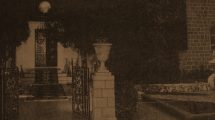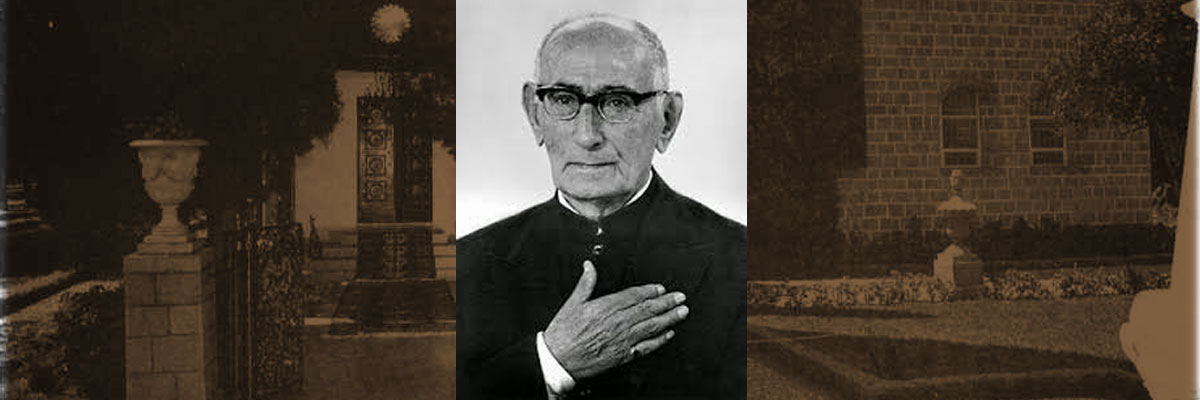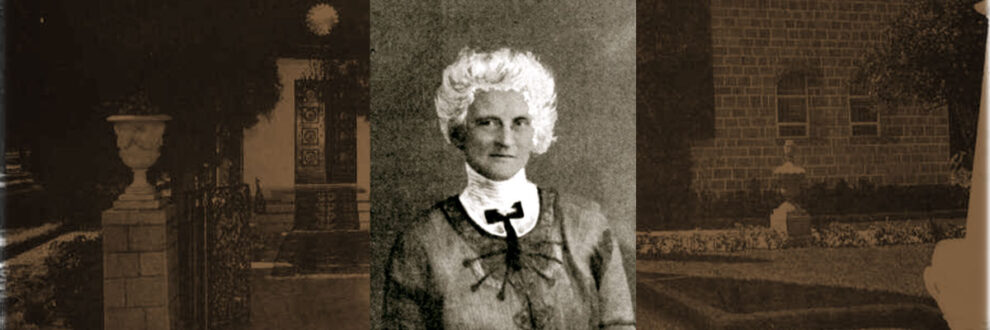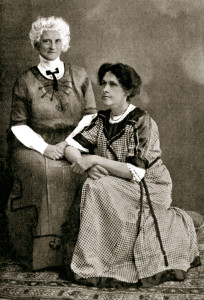 Dr. Susan I. Moody
Dr. Susan I. Moody
Born: November 20, 1851
Death: October 23, 1934
Place of Birth: Amsterdam, New York
Location of Death: Tehran, Iran
Burial Location: No cemetery details
“In reality,” says ‘Abdu’l-Bahá, “faith embodies three degrees: to confess with the tongue; to believe in the heart; to give evidence in our actions.” In writing a brief account of the life of Dr. Susan I. Moody the real faith, as quoted here, is outstanding.
She was born to Scotch-Covenanter parents. She received the usual schooling and orthodox religious training of the “best” families of the day. After graduating from Amsterdam Academy, she taught school, later entered the Women’s Medical College in New York City. After her parents passed away, she made her home with her brother in Chicago where she studied music. Still later, Dr. Moody studied painting and sculpture at the Art Institute of Chicago, then for three years in the Academy of Fine Arts in Philadelphia, then under the great painter Chase, in New York and finally, in the art schools studios of Paris, but she was not, however, to make art her life work for instead of following the professional art career, for which she was well qualified, she finally yielded to the constantly increasing urge which she felt and concluded her study of medicine, graduating from a Chicago medical college.
During those early days of her life in Chicago, she met friends who were attending the first classes formed for the study of the Bahá’í Revelation, which classes she joined but did not become a confirmed believer until 1903, after making an intensive study of the teachings with Mrs. Isabella D. Brittingham, for the privilege of whose teaching Dr. Moody was always exceedingly grateful.
The first Bahá’í Sunday School in Chicago was conducted by Dr. Moody and later she was one of the group of Bahá’í sisters who traveled up and down the outskirts of Chicago’s north side in search of the best location for the now famous Bahá’í Temple in Wilmette, Illinois.
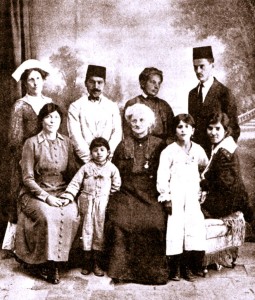 About 1908 a party of American Bahá’ís traveled to Iran to visit the Bahá’ís in that land, and while there some Iranian doctors asked if it would be possible to induce an American woman doctor to come to Tehran, Iran, to live, for the purpose of caring for the women of Iran who at that time were so deprived of skilled medical care. Stopping in ‘Akka, Palestine, on their return, the Americans communicated this wish to ‘Abdu’l-Bahá who asked them if they knew of such a doctor. The name of Dr. Moody was presented, and she received word without delay from ‘Abdu’l-Bahá telling her she had been chosen for this great medical work in Iran. “I knew then,” Dr. Moody often remarked, “why I had felt the urge so strongly to study medicine; I was obliged to study medicine in order to come to Iran.” When the call came from ‘Abdu’l-Bahá, she proceeded immediately on her journey.
About 1908 a party of American Bahá’ís traveled to Iran to visit the Bahá’ís in that land, and while there some Iranian doctors asked if it would be possible to induce an American woman doctor to come to Tehran, Iran, to live, for the purpose of caring for the women of Iran who at that time were so deprived of skilled medical care. Stopping in ‘Akka, Palestine, on their return, the Americans communicated this wish to ‘Abdu’l-Bahá who asked them if they knew of such a doctor. The name of Dr. Moody was presented, and she received word without delay from ‘Abdu’l-Bahá telling her she had been chosen for this great medical work in Iran. “I knew then,” Dr. Moody often remarked, “why I had felt the urge so strongly to study medicine; I was obliged to study medicine in order to come to Iran.” When the call came from ‘Abdu’l-Bahá, she proceeded immediately on her journey.
Enroute to Iran, Dr. Moody stopped in the Holy Land to see ‘Abdu’l-Bahá and receive from Him the necessary instructions and encouragement for the work ahead of her. At the time of parting He said, “You will need patience.” He also further stated that He was sending her to Iran and whether living or dead He would always be with her. During that visit with ‘Abdu’l-Bahá, Dr. Moody made a vow which was, “All that I am and have, and all that I hope to be and have, I dedicate to Thee, O God.” She also said that those three days in the Holy Land with the Master, ‘Abdu’l-Bahá, were all her life.
Dr. Moody arrived in Tehran on November 26, 1909. ‘Abdu’l-Bahá mentioned to some pilgrims the great love with which the Bahá’ís of Iran had greeted Dr. Moody when she arrived in Iran, saying that between Enzeli, on the Caspian Sea, and Tehran there were nineteen relay stations and at sixteen of these there were Bahá’ís gathered to greet the western Bahá’í. Soon after her arrival a reception was given to her and Dr. Moody then knew she had an eternal home in the hearts of these dear friends.
During her fifteen years of service to the Cause in Iran, many were her difficulties and hardships but she had an inflexible determination to accomplish what ‘Abdu’l-Bahá wished her to do.
 Often she prayed for the supreme patience which ‘Abdu’l-Bahá had prescribed. She soon became fluent in the Iranian language. Frequent were her letters to America, explaining her work, enclosing photographs and telling of the lack of freedom and education of the Iranian women, of the custom of wearing the veil, etc., of the Bahá’í work of establishing a hospital, a girl’s school and a Mashriqu’l-Adhkar there. In a Tehran newspaper in 1910 appeared the following:
Often she prayed for the supreme patience which ‘Abdu’l-Bahá had prescribed. She soon became fluent in the Iranian language. Frequent were her letters to America, explaining her work, enclosing photographs and telling of the lack of freedom and education of the Iranian women, of the custom of wearing the veil, etc., of the Bahá’í work of establishing a hospital, a girl’s school and a Mashriqu’l-Adhkar there. In a Tehran newspaper in 1910 appeared the following:
“DOCTOR MOODY-AMERICAN LADY- not only does she know medicine, but also gynecology, obstetrics and women’s diseases. Her good qualities and kind attributes, her love for her Persian oriental sisters, are all equal. Every day from morning till noon she is in her office, No. 10 Avenue Aladauleh, receiving her patients for consultation, examination and treatment, excepting Friday and Sunday afternoons, when she goes to the Hospital Sehat (Hospital of Health), where she meets the patients of the higher and wealthier class.
“We give the utmost thanks and gratitude to such a noble woman, to such a respected person, whose presence here is a great privilege to the country of Persia. On account of the great care of this blessed person, the sick of all nationalities, Moslem, et al., become well. We beg of God to keep this blessed and respected person with US.”
Aside from her medical work, there was ever present in her mind the most important question of the education of girls. Often she would say, “My heart aches for the neglected ones.” She found that many of the Bahá’í men were in full sympathy with her views and through Bahá’í cooperation and consultation a girl’s school was started with an attendance of thirty pupils. It has now an enrollment of several hundred and is known as the Tarbiyat School for Girls. Someone has declared it to be “the greatest among all the schools in Tehran.” One of the activities most dear to the heart of Dr. Moody was the raising of funds for an additional building. She wished this fund to be known as the “Kappes Memorial Fund” in memory of Miss Lillian Kappes, the first American Bahá’í teacher who died in Iran after giving nine years of untiring service to the School. Dr. Moody not only started the Tarbiyat School for the secular education of girls, she also founded the Bahá’í study classes for girls and herself visited these classes every Friday. These study classes were managed by trained teachers and in these classes many who started years ago in the first course … [started] .. teaching others.
Dr. Moody was loved and honored by thousands of people in her life time, among them being Major Robert W. Imbrie, who offered protection to the Bahá’ís and who suffered martyrdom by fanatical Muhammadans. During the epidemic of influenza, the famine and a variety of dreadful conditions, Dr. Moody wrote to America, “Oh, what a mercy that we are alive and awakened and trying to serve in the Kingdom of Abha.” The secret of Dr. Moody’s noble and self-sacrificing life was the fact that it was built on the solid foundation of the Word of God. She had a keen spiritual perception, a pure and undefiled conception of the Bahá’í teachings, and a desire to render instant obedience. She was humble, selfless, and her sense of justice was outstanding.
After fifteen years of unique service in Iran, Dr. Moody returned to America until conditions in Tehran would improve and enable her to resume her work. Accompanied by Miss Elizabeth H. Stewart she made a visit in Haifa and there the writer joined them. Dr. Moody was the first of the four American Bahá’í women to go to Iran and survived the longest.
Dr. Moody, Miss Stewart and the writer arrived in New York City in January,1921, where the Bahá’ís had arranged a reception at the Hotel Waldorf Astoria. Calmly, yet with the dramatic emphasis which always surrounds one who has actually participated in stirring events, Dr. Moody related her experiences in Tehran. After this reception she remarked to the writer, “To return to America and receive such love from the friends, is worth more than any sacrifice one could make.”
That the remarkable work of Dr. Susan I. Moody in Tehran had made her a public figure in this country was well illustrated by extensive articles which appeared in the press. While in Oakland, California, she took a short trip in an aeroplane and the press published her picture with her pilot and an article in part as follows: “According to Dr. Moody, who contrasts her entry into Tehran, the capitol of Iran, in a coach and four where she went to spread the gospel of hygiene to the Muhammadan women, and her exodus in a “flivver” of doubtful vintage twenty years later, she sees no reason why aerial transportation should hold any fears for the women of today.”
During her stay in America from January, 1925, to November, 1928, Dr. Moody was interesting friends to help with the work she, together with the Tehran friends, expected to continue on her return to Iran, the Kappes Memorial School. She was a member of the Revell household in Philadelphia for about a year and during that time although she was then past 75 years of age, yet young in spirit and progressive and active, she studied Esperanto with a class.
In 1928, Shoghi Effendi, the Guardian of the Bahá’í Cause, sent the following instructions to Dr. Moody: “I pray that you may soon in the company of a capable and devoted American co-worker, resume your historic labors for our beloved Cause in Tehran.” Following this suggestion on November 17, 1928, Dr. Moody, then 77 years of age, left for Iran, accompanied by Miss Adelaide Sharp of San Francisco, California, who volunteered her services at the Tarbiyat School in Tehran. To Dr. Moody’s historic career in Tehran was now to be added the final chapter of complete consecration to Bahá’í service. They conferred with Shoghi Effendi in Haifa en route to Iran.
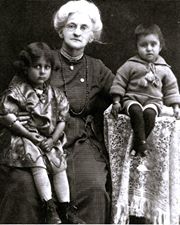 Dr. Moody, named by ‘Abdu’l-Bahá “Amatu’l-A’la” which means ‘the handmaid of the Most High’, wrote of the welcome in Tehran in part as follows: “The friends came singly, in groups, committees, assemblies, more than seven hundred the first week, and still we are greeting many new and old friends, both women and men. Words fail to express the joy of our ‘homecoming.’ I wish you might have seen how that love overflowed in gifts, potted vines, plants, flowers, silver vases, confectionery, sweets of all kinds. Do you wonder why the two Americans were overwhelmed?”
Dr. Moody, named by ‘Abdu’l-Bahá “Amatu’l-A’la” which means ‘the handmaid of the Most High’, wrote of the welcome in Tehran in part as follows: “The friends came singly, in groups, committees, assemblies, more than seven hundred the first week, and still we are greeting many new and old friends, both women and men. Words fail to express the joy of our ‘homecoming.’ I wish you might have seen how that love overflowed in gifts, potted vines, plants, flowers, silver vases, confectionery, sweets of all kinds. Do you wonder why the two Americans were overwhelmed?”
After her return to Tehran, due to age, her health gradually weakened but she continually worked for the Kappes Memorial School, and the friends called on her constantly. At the end of her life when asked for some statement from her regarding her service to keep for posterity, Dr. Moody said, “Let it go, let it pass into the Infinite.”
Shoghi Effendi cabled to America as follows:
“Passing dearly beloved Susan Moody deprives Bahá’í world (of the) far-famed pioneer who, through her indomitable spirit, ceaseless services, earned unique distinction. (She) forged first link in (the) chain uniting (the) spiritual destinies (of the) cradle of our faith (i.e., Persia) and (the) community (of its) stalwart defenders in (the) great American Republic. (I am) instructing Persia rear monument perpetuating memory (of) her noble mission. (I) am gladly defraying whatever expense incurred as token (of) my admiration for community (i.e., America) to which she originally belonged and on which her sacred life shed imperishable lustre. Advise holding befitting Memorial gathering (in) Temple Foundation Hall.”
Her funeral was attended by hundreds of Bahá’í friends. Scores of school girls, with flowers in hand walked in procession through the city for at least one mile to Gulastin-i-Javid (Perennial Garden), the burying ground of the Bahá’ís.
Bahá’u’lláh in one of His Tablets says:
“The soul that hath remained faithful to the Cause of God and stood unwaveringly firm in His path shall, after his ascension, be possessed of such power that all the worlds which the Almighty hath created can benefit through him.”
Source:
The Bahá’í World. Kidlington, Oxford: George Ronald Publisher. Volume 6 1934-1936
-Permission given by George Ronald, Publishers
Images:
bahaiblog.net
centenary.bahai.us
bahaisworldwide.blogspot.com
‘Early Iranian Schools and American Baha’i Women‘: facebook.com

